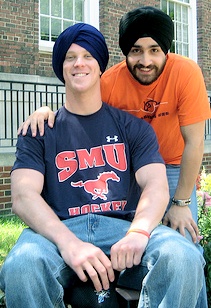Template:AOW199
International Turban Day was started in 2004 to bring awareness of the strict requirement on Sikhs to don the turban as a mandatory part of their religion. Since 9/11 in 2001, the turban has attracted negative attention due to the wrongful linking of this garment with Osama bin Laden, who is a Muslim. Due to the vast news coverage of Osama bin Laden following 9/11, everyone wearing a turban was looked upon as part of his clan or sect and considered to be Muslim. Despite this wrong perception, the vast majority of people who wear turbans in Western countries are actually Sikhs.
The turban or "dastar" or "pagri" often shortened to "pag" are different words in various dialect for the same article. All these words refer to the garment worn by both men and women to cover their heads. It is a headdress consisting of a long scarf-like single piece of cloth wound round the head or sometimes an inner "hat" or patka. Traditionally in India, the turban was only worn by men of high status in society; men of low status or of lower castes were not allowed or could not afford to wear a turban.
Although the keeping of unshorn hair was mandated by Guru Gobind Singh as one of the Five Ks or five articles of faith, it has long been closely associated with Sikhism since the very beginning of Sikhi in 1469. Sikhism is the only religion in the world in which wearing a turban is mandatory for all adult males. .....More

